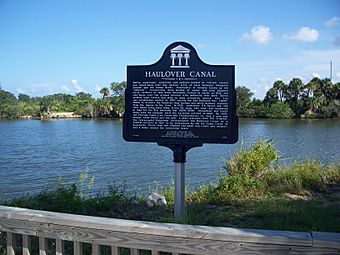Haulover Canal facts for kids
Quick facts for kids Haulover Canal |
|
|---|---|

Haulover Canal Bridge
|
|
| Specifications | |
| Status | Open |
| Navigation authority | U.S. Army Corps of Engineers |
| History | |
| Date completed | 1887 |
The Haulover Canal is a special waterway in Florida. It is located north of Merritt Island, Florida. This canal connects two important bodies of water: Mosquito Lagoon and the Indian River. It is also a key part of the larger Intracoastal Waterway.
In the early 1960s, there were plans to move the canal further north. These plans were later put aside. A new bridge, called the Haulover Canal Bridge, was built in 1964.
Contents
Haulover Canal Bridge
The Haulover Canal Bridge is an important crossing over the canal. It is a drawbridge, which means part of it can be lifted to let boats pass through. This bridge carries SR 3 and Courtenay Parkway. It helps people travel to and from Allenhurst.
History of the Haulover Canal
|
Old Haulover Canal
|
|

Historic marker, with canal in background
|
|
| Location | Brevard County, Florida |
|---|---|
| Nearest city | Merritt Island |
| NRHP reference No. | 78000262 |
| Added to NRHP | December 19, 1978 |
The area around the Haulover Canal has a long history. Long ago, Native American people, explorers, and early settlers needed to move their boats between Mosquito Lagoon and the Indian River. They would "haul" or carry their canoes and small boats over the narrow strip of land. This is how the area got its name, "the haulover."
Early Efforts to Connect the Waters
Connecting these two bodies of water was a challenge for many years. As early as 1605, Spanish explorers visited the area. They would slide their boats over the ground, sometimes using mulberry tree bark to help. Later settlers used rollers and skids to drag larger boats across the land.
During the 2nd Seminole War (1835–1842), a fort called Fort Ann was built nearby in 1837. Its purpose was to protect the haulover area. It also helped move military supplies from the lagoon to the river.
Building the First Canal
In 1852, a contractor named G.E. Hawes dug the first canal. People who were forced to work helped to build it. This first canal was about 3 feet deep and 14 feet wide. It was finished in time for the 3rd Seminole War (1856–1858).
Steamboats and cargo ships used this passage for many years. However, its use changed when the railroad arrived in 1885.
The Modern Haulover Canal
By 1887, a company called the Florida Coast Line Canal and Transportation Company dug a new canal. This new canal was deeper and wider than the first one. It is the canal you can see today, located a short distance from the original.
In 1927, the Intracoastal Waterway project included the Haulover Canal. This made it a federal project. The U.S. Army Corps of Engineers has been in charge of maintaining it ever since. Over the years, the canal has been made even wider and deeper. A special basin was also added for launching boats.
A Historic Landmark
The Old Haulover Canal is recognized as a historic site. On December 19, 1978, it was added to the United States National Register of Historic Places. This means it is an important place that helps us understand the history of the area.



